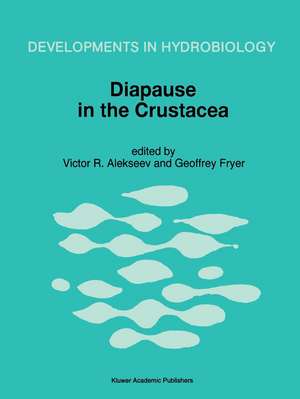Diapause in the Crustacea: A compilation of refereed papers from the International Symposium, held in St. Petersburg, Russia, September 12–17, 1994: Developments in Hydrobiology, cartea 114
Editat de Victor R. Alekseev, Geoffrey Fryeren Limba Engleză Hardback – 31 mar 1996
| Toate formatele și edițiile | Preț | Express |
|---|---|---|
| Paperback (1) | 790.14 lei 38-45 zile | |
| SPRINGER NETHERLANDS – 26 sep 2011 | 790.14 lei 38-45 zile | |
| Hardback (1) | 953.03 lei 6-8 săpt. | |
| SPRINGER NETHERLANDS – 31 mar 1996 | 953.03 lei 6-8 săpt. |
Din seria Developments in Hydrobiology
- 18%
 Preț: 1229.10 lei
Preț: 1229.10 lei - 18%
 Preț: 959.98 lei
Preț: 959.98 lei - 18%
 Preț: 963.91 lei
Preț: 963.91 lei - 15%
 Preț: 648.24 lei
Preț: 648.24 lei - 15%
 Preț: 637.89 lei
Preț: 637.89 lei -
 Preț: 378.25 lei
Preț: 378.25 lei - 15%
 Preț: 644.95 lei
Preț: 644.95 lei - 18%
 Preț: 952.09 lei
Preț: 952.09 lei - 20%
 Preț: 558.87 lei
Preț: 558.87 lei - 18%
 Preț: 1833.65 lei
Preț: 1833.65 lei -
 Preț: 393.59 lei
Preț: 393.59 lei -
 Preț: 406.54 lei
Preț: 406.54 lei - 18%
 Preț: 1226.73 lei
Preț: 1226.73 lei - 18%
 Preț: 956.99 lei
Preț: 956.99 lei -
 Preț: 388.87 lei
Preț: 388.87 lei - 24%
 Preț: 1060.53 lei
Preț: 1060.53 lei - 18%
 Preț: 1229.28 lei
Preț: 1229.28 lei - 20%
 Preț: 569.31 lei
Preț: 569.31 lei -
 Preț: 368.79 lei
Preț: 368.79 lei - 24%
 Preț: 817.48 lei
Preț: 817.48 lei - 18%
 Preț: 958.25 lei
Preț: 958.25 lei -
 Preț: 384.75 lei
Preț: 384.75 lei - 24%
 Preț: 1582.95 lei
Preț: 1582.95 lei - 24%
 Preț: 1051.70 lei
Preț: 1051.70 lei - 18%
 Preț: 943.57 lei
Preț: 943.57 lei - 18%
 Preț: 1235.76 lei
Preț: 1235.76 lei - 24%
 Preț: 800.05 lei
Preț: 800.05 lei - 24%
 Preț: 803.57 lei
Preț: 803.57 lei - 18%
 Preț: 948.29 lei
Preț: 948.29 lei
Preț: 953.03 lei
Preț vechi: 1162.23 lei
-18% Nou
Puncte Express: 1430
Preț estimativ în valută:
182.37€ • 195.01$ • 152.05£
182.37€ • 195.01$ • 152.05£
Carte tipărită la comandă
Livrare economică 18 aprilie-02 mai
Preluare comenzi: 021 569.72.76
Specificații
ISBN-13: 9780792339977
ISBN-10: 0792339975
Pagini: 242
Ilustrații: X, 242 p.
Dimensiuni: 210 x 279 x 16 mm
Greutate: 0.66 kg
Ediția:Reprinted from HYDROBIOLOGICA 320, 1996
Editura: SPRINGER NETHERLANDS
Colecția Springer
Seria Developments in Hydrobiology
Locul publicării:Dordrecht, Netherlands
ISBN-10: 0792339975
Pagini: 242
Ilustrații: X, 242 p.
Dimensiuni: 210 x 279 x 16 mm
Greutate: 0.66 kg
Ediția:Reprinted from HYDROBIOLOGICA 320, 1996
Editura: SPRINGER NETHERLANDS
Colecția Springer
Seria Developments in Hydrobiology
Locul publicării:Dordrecht, Netherlands
Public țintă
ResearchCuprins
Evolutionary aspects of diapause in Crustacea.- Diapause, a potent force in the evolution of freshwater crustaceans.- Types of diapause in Crustacea: definitions, distribution, evolution.- Distribution of crustacean diapause: micro- and macroevolutionary pattern and process.- Egg diapause and clonal structure in parthenogenetic populations of Heterocypris incongruens (Ostracoda).- Influence of parthenogenetic reproduction on the genotypic constitution and evolutionary success of populations and species.- Physiology of diapause.- Variation in torpidity of diapause in freshwater cyclopoid copepods.- Feeding and digestive activity of cyclopoid copepods in active diapause.- On various types of antifreezes in active and resting stages of organisms.- The susceptibility to loss of diapause capacity in hydrobionts of ephemeral waterbodies.- Induction and termination of diapause.- Diapause, quiescence, hatching requirements: what we can learn from large freshwater branchiopods (Crustacea: Branchiopoda: Anostraca, Notostraca, ‘Conchostraca’).- The influence of processing and temperature conditions on hatching of resting eggs of Streptocephalus proboscideus (Crustacea: Branchiopoda: Anostraca).- Significance of photoperiodism and diapause control in the multicycle Crustacean Daphnia pulex Leydig.- The problem of induction and termination of diapause in cyclopoid copepods.- Essentials of the environmental control of insect seasonality as reference points for comparative studies in other invertebrates.- The nature of resting stages and their role in the population dynamics of marine and freshwater crustaceans.- The resting eggs of the Ctenopoda (Crustacea: Branchiopoda): a review.- Ecological and evolutionary significance of resting eggs in marine copepods: past, present andfuture studies.- Copepod eggs survive a decade in the sediments of the Baltic Sea.- Benthic resting eggs of calanoid copepods in Norwegian enclosures used in mariculture: abundance, species composition and hatching.- Role of parthenogenetic natality and emergence from diapausing eggs in the dynamics of some rotifer populations.- Diapause and crustacean life histories.- The biology and morphology of the marine harpacticoid copepod Heteropsyllus nunni Coull, during encystment diapause.- Distribution and summer diapause of Canthocamptus staphylinus (Jurine) (Copepoda: Harpacticoida) in Lake Ladoga.- Diapause in the life cycle of Calanoides carinatus (Kroyer) (Copepoda: Calanoida).- Growth and fecundity of Daphnia after diapause and their impact on the development of a population.- Variable life history of a cyclopoid copepod: the role of food availability.- Diapause of copepods as an element for stabilizing the parasite system of some fish helminthes.- Ecology of diapausing copepodids of Cyclops kolensis Lill. in reservoirs of the Upper Volga.








